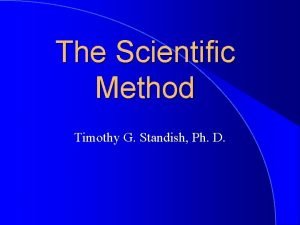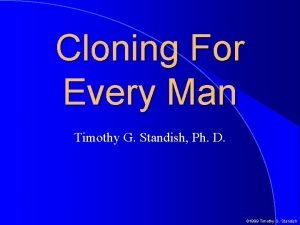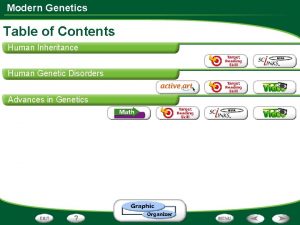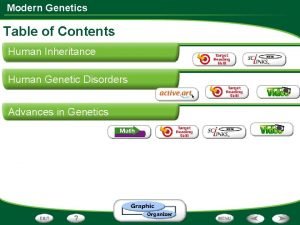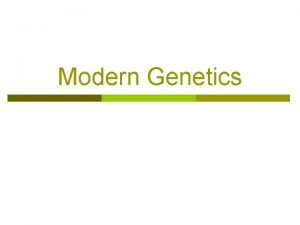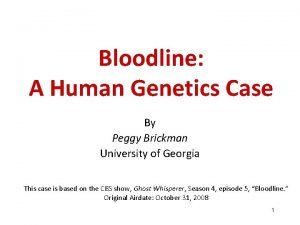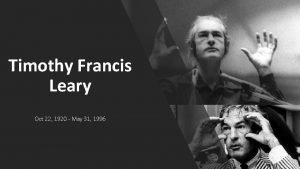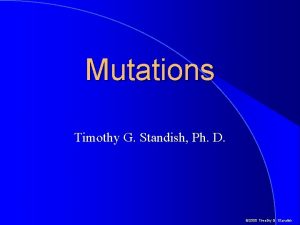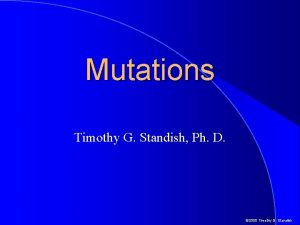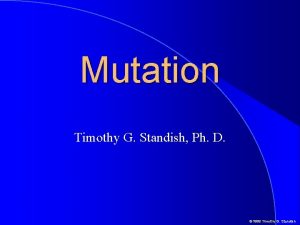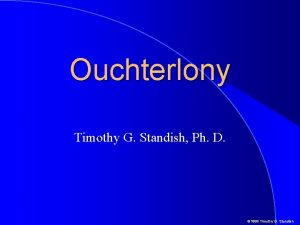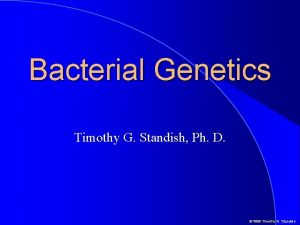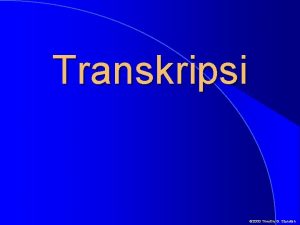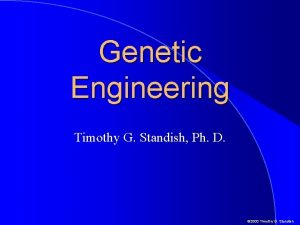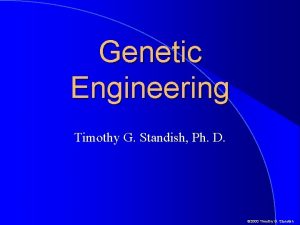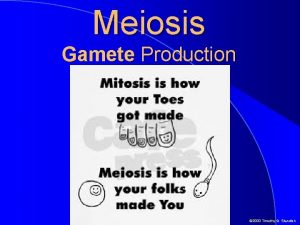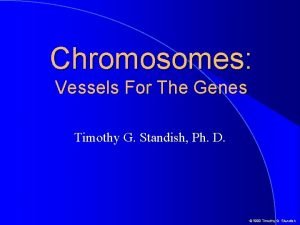Human Genetics Timothy G Standish Ph D 2000
















- Slides: 16

Human Genetics Timothy G. Standish, Ph. D. © 2000 Timothy G. Standish

The Madness of King George III � Partly as a result of the erratic behavior of King George III the American colonies decided to break away from the United Kingdom � Other members of King George’s family also exhibited strange behavior with dire consequences. These included Mary Queen of Scots and her son James I both of whom were beheaded. � Because madness seems to have run in the family, it is thought to have a genetic basis � Acute intermittent porphyria seems to be consistent with the symptoms exhibited by George III © 2000 Timothy G. Standish

Human Heredity Is Not Unique � The genes of humans behave in the same way as genes of other organisms � Of the estimated 100, 000 human genes, most are identical in all humans � The relatively small number of “polymorphic” genes in humans account for only part of the variability that we see between humans � While each human (except for identical twins) has a unique set of genetic information, variation between humans also results from differences in the environment © 2000 Timothy G. Standish

Politics and Genetics � Because we are talking about how humans are when we are talking about human genetics, there can be lots of controversy when traits are seen as relating to race, gender or other sensitive issues � This is particularly true when we start to talk about the genetics of behavior � Nazis and other extreme right wing politicians see human worth and behavior being based on genetics � Communists and other extreme leftwing politicians see humans as infinitely pliable and molded by their environment not genetics © 2000 Timothy G. Standish

Specific Human Traits � Albinism - There a number of different types of albinism, but each is characterized by an absence of pigment from the skin, eyes and hair. Albino individuals typically have very pale white skin, light blue or pink eyes, and light blond or white hair. Albinism is a recessive trait. � Baldness - Loss of hair from the scalp following puberty. A sex influenced trait that is most commonly fully expressed (as a dominant trait) in males, but carried on an autosome. © 2000 Timothy G. Standish

Specific Human Traits � Bent little finger - The little finger noticeably curves toward the other fingers. Bent is dominant to straight. � Brown teeth - Teeth have a brown color that is not the result of poor oral hygiene or antibiotics taken as a child. White teeth are dominant. � Cleft chin - A noticeable indentation at the center of the chin. For examples think of Kirk Douglas and Michael Jackson (after plastic surgery). Having a cleft chin is dominant to a © 2000 Timothy G. Standish

Specific Human Traits �Color blindness - Inability to distinguish between colors of the same intensity. There may be two types, red green color blindness in which individuals perceive red and green as the same color, and complete color blindness in which all colors are perceived as being the same and vision is the functional equivalent of black and white television. Both types of colorblindness are sex linked traits. © 2000 Timothy G. Standish

Specific Human Traits � Dimples - Round indentations in the cheeks when smiling, not lines or clefts. � Double-jointed thumbs - This is commonly called a hitchhiker's thumb. The thumb can bend back at almost 90 degrees. Hitchhiker's thumb is a recessive trait, but it may vary in its expression. � Ear lobes attached - The lobes at the bottom of the ear are either not present, or are attached to the side of the head on their full length. Attached is recessive. © 2000 Timothy G. Standish

Specific Human Traits � Eye color - Eye color may vary from violet to bright blue to gray. Other eye colors include green, brown, black, and yellow. Albinos may have red eyes as albino laboratory white rats do. Eye color is determined by two traits, one that controls the texture of the iris and a second determining the relative abundance of a brown pigment called melanin. The surface of the iris determines the blueness of the eyes. When a small amount of melanin is present, green eyes result while brown and black eyes result from relatively increasing amounts of melanin. For the purposes of this exercise, determine the presence or absence of © 2000 Timothy G. Standish

Specific Human Traits � Index finger shorter than ring finger - The index finger (next to your thumb) is longer than the ring finger (next to your little finger). This is a sex influenced trait. Check the class data to see if the frequency is different for the different sexes. � Freckles - Small patches of darker pigmented skin on various parts of the body and most visible in those areas commonly exposed to the sun. These may be present on both dark and light skinned individuals. © 2000 Timothy G. Standish

� Hair Specific Human Traits color - The wonders of modern technology have provided many ways in which phenotype can be altered. Hair color is the most commonly altered phenotype. Record your true unaltered phenotype unless your hair has turned gray or white in which case the color before it changed should be recorded. Multiple alleles control hair color. � Hair whorling. These may be referred to as cowlicks. Areas in which hair grows from your scalp in a whorl instead of in a given direction. © 2000 Timothy G. Standish

Specific Human Traits � Hand folding - When the hands are folded either the left or right thumb will be on top. Record which thumb feels most natural on top. Left thumb on top is dominant. � Mid-digital hair - Hair growing from the middle section of each finger. Hair presence is dominant. � Myopia - Short sightedness, the inability to see far off objects without correction by glasses or contacts. If you have had surgery to correct this problem, record yourself as © 2000 Timothy G. Standish

Specific Human Traits �Polydactyly - Having more than five digits on each hand foot. �PTC tasting - Phenylthiocarbamide (PTC) is a bitter tasting chemical that cannot be tasted by some individuals. Paper with PTC on it will be provided. Place a small piece in your mouth. If you taste a distinct bitter taste, you are positive for PTC tasting. Tasting is dominant to the inability to taste PTC. © 2000 Timothy G. Standish

Specific Human Traits � S-methyl thioester smeller - S-methyl thioesters are produced in urine following the consumption of asparagus. Some individuals cannot smell this substance. Eat at least five spears of asparagus then note down any unusual odor the next time you urinate. If you smell a strong odor on urination, you are an Smethyl thioester smeller. � Tongue rolling - Tongue rolling is the ability to form a tube with your tongue. Rolling is dominant. © 2000 Timothy G. Standish

Specific Human Traits � Tongue rolling - Tongue rolling is the ability to form a tube with your tongue. Rolling is dominant. � White forelock - A white patch of hair at the front of the scalp. � Widow's peak - A sharp point in the hairline that points toward the nose. Having a widow's peak is dominant to a smooth hairline. © 2000 Timothy G. Standish

 Timothy g. standish
Timothy g. standish Timothy standish
Timothy standish Timothy g. standish
Timothy g. standish Timothy standish
Timothy standish Skyward standish
Skyward standish Standish management
Standish management Standish group chaos report 2020
Standish group chaos report 2020 Human inheritance modern genetics answer key
Human inheritance modern genetics answer key Modern genetics human inheritance answer key
Modern genetics human inheritance answer key Modern genetics human inheritance answer key
Modern genetics human inheritance answer key Biologists search the volumes of the human genome using
Biologists search the volumes of the human genome using Human genetics concepts and applications 10th edition
Human genetics concepts and applications 10th edition Bloodline a human genetics case answer key
Bloodline a human genetics case answer key My parents kept me from children who were rough
My parents kept me from children who were rough Timothy winters worksheets
Timothy winters worksheets Timothy francis leary
Timothy francis leary 2 timothy 2:3-4
2 timothy 2:3-4
